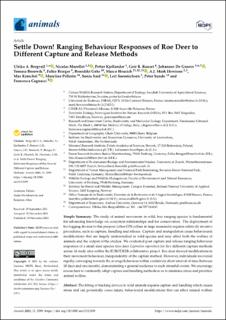Settle down! ranging behaviour responses of roe deer to different capture and release methods
Bergvall, Ulrika A.; Morellet, Nicolas; Kjellander, Petter; Rauset, Geir R.; De Groeve, Johannes; Borowik, Tomasz; Brieger, Falko; Gehr, Benedikt; Heurich, Marco; Hewison, A.J. Mark; Kröschel, Max; Pellerin, Maryline; Saïd, Sonia; Soennichsen, Leif; Sunde, Peter; Cagnacci, Francesca
Peer reviewed, Journal article
Published version

Åpne
Permanent lenke
https://hdl.handle.net/11250/3038832Utgivelsesdato
2021Metadata
Vis full innførselSamlinger
- Publikasjoner fra CRIStin - NINA [2364]
- Scientific publications [1392]
Sammendrag
Research in global change ecology relies heavily on global climatic grids derived from estimates of air temperature in open areas at around 2 m above the ground. These climatic grids do not reflect conditions below vegetation canopies and near the ground surface, where critical ecosystem functions occur and most terrestrial species reside. Here, we provide global maps of soil temperature and bioclimatic variables at a 1-km² resolution for 0–5 and 5–15 cm soil depth. These maps were created by calculating the difference (i.e., offset) between in-situ soil temperature measurements, based on time series from over 1200 1-km² pixels (summarized from 8500 unique temperature sensors) across all the world’s major terrestrial biomes, and coarse-grained air temperature estimates from ERA5-Land (an atmospheric reanalysis by the European Centre for Medium-Range Weather Forecasts). We show that mean annual soil temperature differs markedly from the corresponding gridded air temperature, by up to 10°C (mean = 3.0 ± 2.1°C), with substantial variation across biomes and seasons. Over the year, soils in cold and/or dry biomes are substantially warmer (+3.6 ± 2.3°C) than gridded air temperature, whereas soils in warm and humid environments are on average slightly cooler (-0.7 ± 2.3°C). The observed substantial and biome-specific offsets emphasize that the projected impacts of climate and climate change on near-surface biodiversity and ecosystem functioning are inaccurately assessed when air rather than soil temperature is used, especially in cold environments. The global soil-related bioclimatic variables provided here are an important step fThe fitting of tracking devices to wild animals requires capture and handling which causes stress and can potentially cause injury, behavioural modifications that can affect animal welfare and the output of research. We evaluated post capture and release ranging behaviour responses of roe deer (Capreolus capreolus) for five different capture methods. We analysed the distance from the centre of gravity and between successive locations, using data from 14 different study sites within the EURODEER collaborative project. Independently of the capture method, we observed a shorter distance between successive locations and contextual shift away from the home range centre of gravity after the capture and release event. However, individuals converged towards the average behaviour within a relatively short space of time (between 10 days and one month). If researchers investigate questions based on the distance between successive locations of the home range, we recommend (1) initial investigation to establish when the animals start to behave normally again or (2) not using the first two to three weeks of data for their analysis. We also encourage researchers to continually adapt methods to minimize stress and prioritize animal welfare wherever possible, according to the Refinement of the Three R’s. box trap; Capreolus capreolus; net drives; net trap; roe deer; 3R’s
